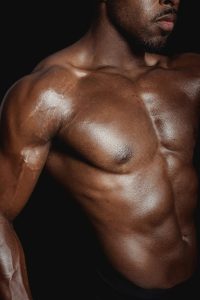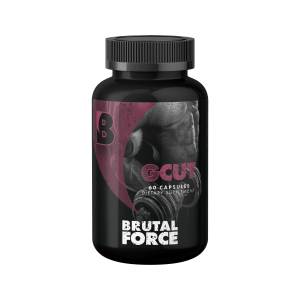Table of Contents
Dealing with gynecomastia as a bodybuilder can be a real headache. You're working hard to sculpt your physique, aiming for that sharp, defined chest, and then boom, you notice your chest looking a bit, well, less chiselled than you'd like, thanks to the dreaded bodybuilder gyno.
This isn't just about feeling a bit self-conscious; for competitive bodybuilders, it can directly impact their success on stage, where every muscle counts.
Let's break down what gynecomastia is first, why it often shows up in bodybuilders, and what you can do about bodybuilder gyno.
So, What Exactly is Gynecomastia?
Gynecomastia is when male breast tissue enlarges abnormally. Think of it as having more breast tissue than is typical for men. It's important to know that this isn't just about having extra fat on your chest, which is called “pseudogynecomastia“.
True gynecomastia involves both glandular (breast) tissue and fat. It can affect one or both sides of your chest and vary in how noticeable it is.
Why Bodybuilder Gyno? The Hormonal Link
The biggest reason bodybuilders might get gynecomastia often comes down to hormonal imbalances. Specifically, it's usually about having too much estrogen compared to testosterone. Normally, testosterone helps keep breast tissue from growing, while estrogen does the opposite; it stimulates breast development.
Here's where it gets particularly relevant for bodybuilder gyno:
- Anabolic Steroid Use: This is a major player in hormonal disruption for many in the bodybuilding community. Anabolic steroids, used to build muscle and boost performance, can lead to your body producing too much estrogen. This excess estrogen is a primary driver of breast tissue growth.
- The Fat Loss Paradox: Oddly enough, gynecomastia can become more prominent when bodybuilders are shedding fat to get “stage-ready”. As your overall body fat percentage drops to super low levels, any existing glandular tissue becomes much more visible against your hard-earned muscl
e definition. There's simply less surrounding fat to hide it. This can be pretty distressing for athletes who rely on a symmetrical and aesthetic physique for competition.
How Does It Feel and Look?
You might notice breast tenderness, sensitivity, or a clear increase in breast size. Sometimes, there might even be nipple discharge. If you're concerned, it's always a good idea to chat with a health professional.
The Emotional Toll
Beyond the physical appearance, bodybuilder gyno can take a significant toll on a man's mental well-being and self-esteem. For men, breast development is typically seen as a female trait, and having enlarged breasts can lead to feelings of embarrassment, anxiety, emasculation, and even depression.
The psychological impact of bodybuilder gyno can be especially profound if it starts during adolescence, making some men feel “unacceptable”.
The 3 Stages of Gynecomastia
Bodybuilder gyno doesn't just appear overnight; it typically progresses through three stages over about a year. Understanding these stages can help in deciding the best course of action:
- Florid Stage: This is the initial phase, lasting about 4 to 6 months. Glandular tissue is actively growing, and you might feel tenderness or pain in the breast area. Getting treatment at this stage can sometimes slow or stop further development.
- Intermediate Stage: This transitional phase lasts for the next 4 months. Growth starts to stabilise, and the breast tissue is still relatively soft, though less tender than before.
- Fibrous Stage: In this final 4-month stage, the breast tissue becomes dense and fibrous. This is usually a permanent change, and at this point, non-surgical methods are less likely to be effective, making surgery a more probable solution. This stage is more common if gynecomastia has lasted longer than a year.
Dealing with Bodybuilder Gyno: Your Best Options
There are a few ways to tackle gynecomastia, from non-surgical approaches to surgical intervention.
1. Non-Surgical Treatments
These methods focus on addressing the root causes and can help reduce breast tissue without an operation.
- Hormone Management: If hormonal imbalances are the culprit, your doctor might suggest testosterone replacement therapy to help balance your oestrogen and testosterone levels. Other medications, like Tamoxifen and Raloxifene, which are selective oestrogen receptor modulators (SERMs), can be very helpful by blocking oestrogen's effects on breast tissue.
Tamoxifen, in particular, has been found to be effective, safe, and with minimal side effects in many studies. Aromatase inhibitors (like Anastrozole and Testolactone) are also used to reduce estrogen production. It's crucial to discuss these options with a healthcare provider.
- Diet and Supplements: Eating a balanced diet and exercising regularly support overall hormonal health. Some vitamin supplements, like Vitamin D, and foods like cruciferous vegetables, may help maintain hormonal balance.
Reducing intake of foods with phytoestrogens (like soy or liquorice root) might also help improve your testosterone-to-estrogen ratio. The Mediterranean diet is a good choice for overall health and weight management.
If you're a bodybuilder dealing with the frustrating signs of gyno, like puffy nipples or stubborn chest fat, it's time to take control. You’ve worked hard to build your physique, so don’t let hormonal imbalances or leftover bulk hide your gains.
GCUT is a natural, non-surgical option designed to support hormone balance and help flatten your chest without killing your workouts or cutting cycles short. Want to see how it stacks up and whether it’s right for your routine?
Read my full GCUT review now
- Exercise and Weight Management: While exercise can't directly remove glandular breast tissue, it's a great tool for reducing overall body fat. If your chest fullness is mostly due to fat (pseudogynecomastia), exercise can significantly improve its appearance.
Even with true bodybuilder gyno, reducing overall body fat can make the glandular tissue less noticeable.
-
- Cardio: Activities like brisk walking, jogging, swimming, skating, dancing, rowing, or skipping can help burn fat. The key is consistency and intensity, not just the type of exercise.
- Strength Training: Exercises that build chest muscles, such as push-ups and bench presses, can improve chest contour. Remember to use proper form and consider a spotter for exercises like bench presses.
- Other Tips: Maintaining a healthy diet of lean proteins, vegetables, fruits, whole grains, and plenty of water is essential. Managing stress and ensuring you get at least 7 hours of sleep can also support hormonal health.
2. Surgical Treatments
When non-surgical options aren't enough, especially for severe cases or fibrous tissue, surgery becomes a viable solution.
- Male Breast Reduction Surgery: This procedure involves removing excess fat and glandular tissue to reshape the chest, aiming for a more masculine contour.
- Surgical Techniques:
- Liposuction: If there's primarily excess fat and good skin elasticity, liposuction alone can be used to remove fat through small cuts.
- Direct Excision: For firmer glandular tissue, especially behind the nipple, a cut is typically made along the lower edge of the areola to remove the tissue.
- Combination: Often, both liposuction and direct excision are used together, especially when there's a mix of fat and glandular tissue.
- Nipple Transposition: In very severe cases with a lot of excess skin, procedures like nipple transposition might be needed to correctly reposition the nipple.
- Recovery and Results: After surgery, you'll usually wear compression garments for about four weeks to aid healing and reduce swelling. Most patients can get back to work and light activities within a few days, though strenuous exercise should be avoided for around 3 weeks. Patients generally report increased confidence and comfort post-surgery, with aesthetically pleasing results in a high percentage of cases.
Prevention is Key to Stopping Bodybuilder Gyno
- Avoid Anabolic Steroids: This is crucial, as they are a significant cause of hormonal imbalances and carry numerous health risks, including liver damage and cardiovascular issues. Always opt for natural muscle-building methods like proper nutrition and training.
- Monitor Hormone Levels: Regular check-ups can help identify any hormonal imbalances early on, allowing for timely adjustments to your lifestyle or treatment plan.
- Healthy Lifestyle Choices: Sticking to a balanced diet, regular exercise (both cardio and strength training), and limiting alcohol intake are all vital for maintaining hormonal balance and a healthy weight, which can minimise the appearance of gynecomastia.
Understanding bodybuilder gyno, its causes, and the available treatment and prevention strategies is essential for any man. With the right approach, you can work towards achieving that masculine chest contour and maintain your confidence and overall well-being.


